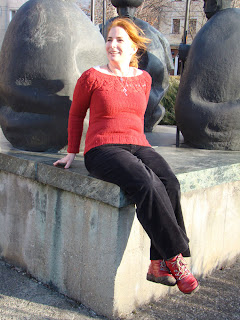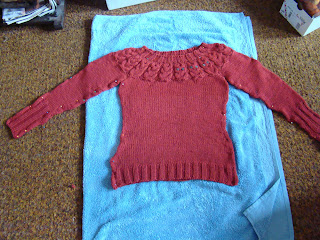I’ve been planning this post for a while, but the recently flared up discussion made me actually do it.
The basic question was which yarn acts how, especially when it gets into contact with water, is it really necessary to swatch, (does the necessity of swatch has any connection of the price and quality of a yarn), does the yarns pilling, and why, and problems in this flow. Please note that what is written below is my experience, not results a scientific experiments. Nor do I wish to grade any of the yarns.
Well, the story of a yarn (if we leave out the live sheep and the scissor story) starts with spinning. The basic qualities of a yarn (I will talk about wool, or yarns with high wool content now) depends on the material, fiber and the way it is spun. If the spinner lets it have much twist it will be more rigid, if it has less twist it will be softer. Picture a loosely spun yarn, the ends of the fibers are not stuck together, the fibers can get out more easily, loosely spun yarn pills much more easily. I could say that the softness of the yarn is in direct ratio with its tendency to pill. When selecting or buying yarn, I always think through if I am willing to sacrifice softness for longevity, or will I suffer the little balls of pilling for the softness.
We also have to remember that wool contains natural oils, and this lanolin is often used at spinning factories, along other greases. There are yarns you can buy in this raw state, right after they’ve been spun. Yarns you can buy on cones are often this type. Between the fibers of these yarns the lanolin or other greases are still there, the ends are still stuck to each other and the surface. When washed these yarns „bloom”, the grease dissolves, the fibers loosen and the knitted fabric becomes softer but hairier too. Because of the loosened hairs the fabric also gets denser. From the yarns I used lately the ones coming from Scotland (Kingcraig’s) and ColourmartUK act like this, and that rainbow colored Estonian one Barka sold for a while last winter.
However, most yarn are treated in the factories. They are washed, dried, blocked, and treated other ways to be softer, loftier. Yarn manufacturers, like everybody doing something with manufacturing has a basic interest in making from the least possible base material, the most possible final product. So they tend to spin yarns more loosely, let more air between the fibers, and with the after spinning treatment do this even further. Also a natural, lets say basic marketing trick to package the goods in a way that they look…more. Did you ever put together a ball from a store, and a hand-rolled one (from the same length and weight)? How much bigger the loosely winded factory ball? True, it is more difficult to handle it often falls apart and makes the yarn a tangled mess, but we are used to the bigger balls, and if we would look at a tightly wound ball we would just turn away: such a small amount.
Because of this, when water touches the yarn the air goes out, the fibers stuck together from the moisture, the whole thing gets thinner, I like the expression of “relaxes”. In my experience this happens to every yarn, except the untreated types I mentioned at the beginning. The Merino Blend of King Cole one of the local sellers have does this in a scary proportion, but happened also to the GGH Camello I used in the sweater in my last post, and that one cannot be put in the “cheap yarn” category.
There is only one way to counteract this. Yes, by swatching. Yeah, most yarn comes with suggestion to what gauge to knit it with what size of yarn, but not only changes from person to person how tight or loosely we knit, but also how dense we like out knitted fabric. I, for one knit idiotically loosely, but I also like if my knitted fabric denser than the suggested. This firstly is a personal preference but secondly… as we already seen with spinning, the tighter the yarn is spun, the longer it lasts, the tighter something is knitted, harder it is for the tiny fibers to get free and pill, or less space for the yarn to relax, so the end product will keep its shape longer. So if the suggested needle size is 4.5 mm, I start swatching with 3mm.
Yes, with a very few exception I ALWAYS knit swatches, and always wash and dry my swatch before I start knitting the actual piece. Simply there is no way around it.
I’ve knitted for almost forty years, used up a couple of hundred thousand meters of yarn. I like to think about myself, that I can tell from looking and touching the needle size necessary for me to get the texture I like, but as I said earlier… Who should honor my time and my work if I don’t? I do not have any extra time. But I know that the foundation of a good work is the through preparation, and careful finishing. I learned through the years that yarns act like this, no matter what. Linen or cotton fabrics shrink if washed, but I don’t take it back to the store because of this. I take it into consideration and wash them before cutting.
When knitting I knit swatches, with several needle sizes if I am in doubt, wash, dry and then examine it before knitting. This takes half an hour or so, but I think it is more than worth it, not only because I save the possible unnecessary work, frogging and/or annoyance, but also the worry. And it gives me an opportunity to try out, or lets say practice if the pattern calls for some unusual pattern, or trick.
Wool, due the nature of the fiber adapts. It has little scales on its surfaces, if these are loosened (by soap) and pressed together (by washing) they stuck, , so the fabric becomes smaller, it felts. On the other hand the fibers are not straight, but spirally, therefore flexible, we use this to our advantage when pulling out a lace shawl twice its original size. It is only natural, if a sweater does the something similar when wet.
The only way to counteract this to use smaller needles, knit tightly, smaller than necessary pieces, and to wash it, pulling it into shape when wet. Some of my knitting looked ridiculously small; I got asked if I am knitting for a child.
For me a knitted piece is finished when the last end is woven in, the last button is sewed on, and the piece at least rinsed (or lightly washed) and blocked. With the rinsing/washing I get rid of the dirt accumulated by spinning, shipping and knitting, the yarn gets into its final shape, and I have the knit dry in its final shape and size.
If I do this, and if I handle handmade piece with the attention it deserves… I will not get surprises later.
Of course I don’t mean to poke on those who had their sweater, (or other knitted item) grow beyond help after washing, nor do I want to imply I never make mistakes. Oh, how many of them… I had elastic band sewn on the edge of a beret, because it grew, sewn Icord ties on the waist of a top because it was too wide, and I also have a very long scarf where I intended to have a very wide stole.
In other words as the slogan of a colleague says, it’s not the water’s fault, if you can’t swim. It is (most probably) not the yarns fault, if it is not acting as we expect it. We just have to learn how to deal with each yarn. And the best way to get familiarized with them is by swatching.
















